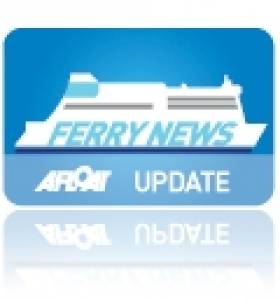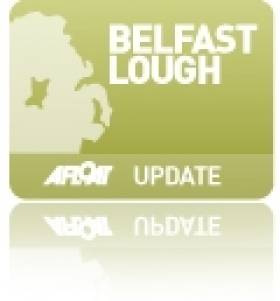Displaying items by tag: Belfast Lough
Mumbo Jumbo Hangs on for Win at Belfast Lough Autumn Keelboat Series
Charlie West–Hurst's Mumbo Jumbo won their first race of the Belfast Lough Autumn Keelboat Series last Sunday morning, finishing just behind the other NIRKRA competitors to win on handicap. This was the fourth different winner in as many weeks with only 2 minutes seperating the fleet on corrected time.
Racing was postponed initially on Sunday morning with racing looking unlikely with little wind forecast until the afternoon but some lovely early Autumn sunshine for everyone to enjoy. Thankfully after just 20 minutes, a brisk Southerly 8-12 knots set in to Race Officer Colin Loughead's joy who got racing started quickly.
The IRC fleet got away first with Giggle tramping away as expected from the smaller Final Call. The Sigma fleet followed with tight racing around the first two laps when Impulse and Cariad got into a private duel allowing the other two to escape. Sqwawk repeatedly tried to escape Burton Allen's Starshine Challenger upwind but was dragged back on the runs with only boat lengths separating them at the final leeward mark. Paul Prentice's team hung on for a 3rd win in the series and overall lead.
In the Restricted Whitesail NHC class John Moorehead's Margarita scored their second win of the series with a good lead at the finish over Mingulay and the following Enigma.
The smaller NIRKRA fleet saw the tightest racing with David Milne's Manzanita leading from QtPi and Starflash. The latter broke through by the end to finish second over the water but has suffered from her successes earlier in the season and her henceforth higher NHC handicap to drop to 6th on corrected time. Manzanita could look back to see the chasing "slower" Chatterbox followed closely by Mumbo-Jumbo who was enjoying the freshening breeze and won the race by just 10 seconds. The NIRKRA class was set up 2 years ago with a restricted banding centered around the old quarter-tonner mark and this series has shown the competitive nature of the fleet with four different winners in as many races and only 2 points seperating the first 4 boats overall.
Next Sunday's racing looks to be a bit fresher with the imminent leftovers of Hurricane Joaquin. There are 3 races still left in the series with all classes still up for winning. Many thanks to David and Elaine Taylor for lending Whiskey Mac to be the committee boat.
Full results here
Restored 1897 Belfast Lough OD Tern Makes Successful Debut At Les Voiles De St Tropez 2015
The 1897-built Fife-designed 37ft Belfast Lough One Design Tern has made a successful debut in the classics scene in the Mediterranean by winning her class in Les Voiles de St Tropez 2015 writes W M Nixon.
We’ve reported from time to time on the Mallorca-based restoration project on Tern on Afloat.ie over the past 18 months. But we were keeping our fingers crossed that all would continue to go well after her successful launching on August 6th - so much effort was going into the final work and detailed finishing that, with time limited before she could be taken to the major regattas in the south of France, all and any sorts of hitches could still occur.
Since then, there has been further concern with the weather in southeast France being exceptionally bad, with seriously adverse effects in recent days on the classic events in both Cannes and St Tropez. But Tern has not only come through unscathed, she has won her class overall despite the fact that there was only racing on two days at St Tropez, recording a first and second.
This has all been hugely confidence-building for the team involved, and greatly improves the likelihood of Tern coming to Ireland next year. The Royal Ulster Yacht Club on Belfast Lough – which was her home club in her early days and still displays several photos of Tern and her six pioneering sisters from 1897 and 1898 - is celebrating its 150th Anniversary in 2016, while at different times Tern was also based in Cork Harbour, Waterford and Dun Laoghaire, and she was one of the five yachts taking part in the Founding Cruise of the Irish Cruising Club to Glengarriff in July 1929, giving Tern direct links with all of the Irish coast between West Cork and County Antrim, as she was built by Hilditch in Carrickfergus.
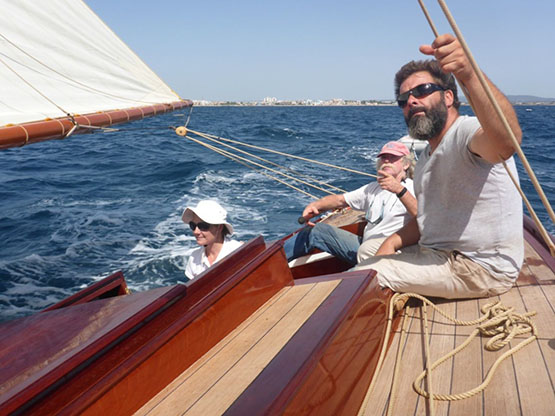
Aboard Tern on her first sail since restoration, off the coast of Mallorca in August
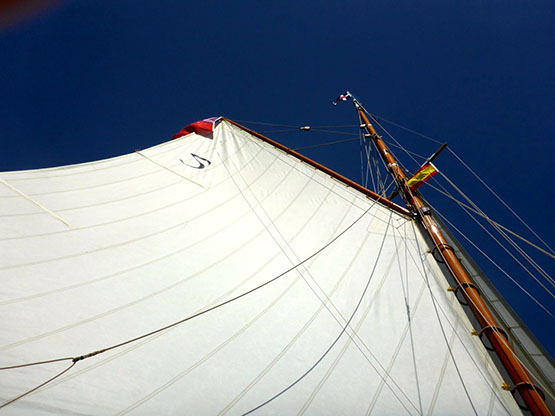 When the new Belfast Lough ODs started racing in May 1897, it all happened so quickly that when sailmakers Ratsey & Lapthorne at their Scottish loft found that they lacked Tern’s allocated sail number 7, shortage of time meant they simply used an inverted 2 instead, and this has been faithfully replicated in the new 2015 sails, also made by Ratsey & Lapthorne.
When the new Belfast Lough ODs started racing in May 1897, it all happened so quickly that when sailmakers Ratsey & Lapthorne at their Scottish loft found that they lacked Tern’s allocated sail number 7, shortage of time meant they simply used an inverted 2 instead, and this has been faithfully replicated in the new 2015 sails, also made by Ratsey & Lapthorne.
As well, the hull lines of the BLOD 25s from 1897 were then used for the building of the Dublin Bay 25s from 1898 onwards, though the Dublin Bay boats had a higher specification, and carried a lead ballast keel instead of the Belfast Lough boats’ less expensive cast iron.

One of the famous William Maguire Dublin Bay models in the National Yacht Club is of the Fife-designed Dublin Bay 25ft OD, whose hull lines were identical to Tern. And Tern herself - though by that time rigged as a cruising yawl - was based at the National YC from 1944 to 1954, firstly under the joint ownership of Charles E Hogg and Maurice Healy from 1944 to 1949, and then under the ownership of J J Lenihan until 1954, after which she moved to Falmouth in southwest England. Photo: W M Nixon
Montrose wins Waverley Cup at Belfast Lough Autumn Keelboat Series
Another beautiful morning's race saw the half-way stage of the Belfast Lough Autumn Keelboat Series and the end of the Waverley series. The 18 boat fleet have enjoyed 3 very enjoyable races so far in gorgeous sunshine, wondering why the rest of the summer wasn't the same. We can only hope that October fares similar.
Tradtional tight racing in the 110 year old Waverley class has seen all of the boats win one race. John McCrea's Ivanhoe won the final one but any hopes of winning the series overall were dashed when the husbacnd and wife team of Robin "Sailor" and Victoria Millar folowed them home in front of Ben Gouk's Fair Maid, winning the series by a single point.
In the IRC fleet, Phil Davie's Giggle took advantage of the absence of Indigo to take the lead in the series overall with 2 wins from Richard and Pauline Donnan's 1. John Minnis and B Roche are enjoying their first few races in their new Final Call but finding it hard to stay close enough to the bigger yachts.
In the Sigma's, Sqwawk struggled with the lack of their leader Paul Prentice and a depleted team on duty at the RYANI Youth Nationals and elsewhere. Even in relatively light winds, Johnny Henry struggled to keep the boat upright enough with only 2 on the rail, and Starshine Challenger took advantage to score their first win of the series. Special mention must be made of Burton Allen (and Adrian Allen) who was absent due to attending the wedding of his grandson Michael.
The NIRKRA fleet have also seen different winners in each race and this week was the time for Garth and Myles Lindsay's Johnathon Star to maximise the advantage from their bigger sail plan to lead by 90 seconds over the water from Jim Coffey and Tom Bell's QtPi with David Milne's Manzanita just behind. Last week's winner Chatterbox was 5th on corrected time struggling in the lighter winds in Race 2 and 3 having ran Manzanita close in Race 1, coming 2nd in that race only 3 seconds behind on corrected time. Alan Morrison's Starflash has struggled so far this series on handicap, possibly due to success earlier in the year when they were setting the benchmark. Only 5 minutes on the water separated the 6 boat fleet in the first two races showing the competitive nature of this restricted class. After 3 races, Johnathon Star leads from Manzanita and Chatterbox by 2 points.
The whitesail NHC fleet have also enjoyed changing fortunes and having won the first two races and leading the series overall, John Ritchie's Mingulay saw D Lowe's Gecko cling on close enough to the quicker boats last Sunday to clinch the race on handicap although the results posted look a bit irregular and may need reviewed. John Moorehead's Margarita was 2nd and lies 3rd overall behind Messrs Curry, Wilde and Nixey in Enigma in 2nd place.
Many thanks must go to Colin Loeonard who has set great courses over the first 3 races. We now look forward to Elaine Tyalor who will take over for the remaining 4 races running until 25th Oct
October.
IRC Fleet
1st Giggle RUYC Phil Davis
2nd Indigo RUYC R & P Donnan
3rd Final Call RUYC J Minnis/ B Roche
SIGMA Fleet
1st Squawk BYC/RUYC P Prentice
2nd Starshine Challenger BYC/RUYC B Allen
3rd Cariad BYC/RUYC G Bell
NHC Fleet
1st Mingulay RUYC J & M Ritchie
2nd Enigma BYC/RUYC Messrs Curry/Wilde/Nixey
3rd Margarita RUYC J Moorehead
NIRKRA Fleet
1st Jonathan Star RUYC G Lyndsay
2nd Manzanita BYC/RUYC D Milne
3rd Chatterbox RUYC/BYC D Quinn
WAVERLEY Fleet
1st Montrose RUYC/BYC R & V Millar
2nd Ivanhoe BYC/RUYC J McCrea
3rd Fair Maid BYC B Gouk
Bangor RNLI Celebrates 50 Years Of Lifesaving
#RNLI - On Friday 5 June, Bangor RNLI’s volunteer lifeboat crew, fundraisers and supporters gathered at the Marine Court Hotel to celebrate 50 years of saving lives at sea.
Records held in the archives of Bangor lifeboat station indicate that a lifeboat in Belfast Lough was first established at Groomsport in 1858, following the wrecking of a vessel near Bangor, with the loss of all the crew and in full view of local people standing on the shore.
Groomsport lifeboats launched 55 times and saved 87 lives over a period of 62 years from 1858 to 1920, when the station was closed.
It was reported that the number of lifeboat services were not more numerous due to the great number of fisherman and pilots in the area "of a fine and hardy type, who are not slow to risk their lives in their own boats, in which they have great confidence."
Some 45 years after the closure of Groomsport Lifeboat Station, an ever-increasing demand for lifesaving services along the coast led to considerations of re-establishing a lifeboat service in the Belfast Lough area.
Under the guidance of Ernie Hay, the first honorary secretary and North Down Borough Council officer, the RNLI chose to place a D-Class inflatable lifeboat at Bangor Harbour, opening for business on 15 May 1965.
With the co-operation of North Down Borough Council, the lifeboat was stored in the Tower House yard and was launched on a trolley at the slipway beside the old Harbour Masters Office. The co-operation between North Down Borough Council and the RNLI has continued without a break since those times.
The service of the lifeboat continued under the care of local volunteers and the demands put upon her volunteer crew increased year on year. Successive honorary secretaries managed the operational demands and the branch fundraising committee and ladies’ guild worked hard behind the scenes, raising the funds to cover operational costs. Over 40 local businesses also contributed to the funds by maintaining collecting boxes on their premises.
In 1984, following the construction of the Eisenhower Pier, North Down Borough Council built a new boathouse and slipway, which allowed for the subsequent upgrading of the boat to an Atlantic 21 class lifeboat, the then ‘Rolls Royce’ of fast inshore lifeboats.
The Youth of Ulster, a new boat funded by local donations, was put on station in 1990 and was formally named by HRH Prince Edward, Earl of Wessex in 1991.
In 2002 the RNLI invested £250,000 in building a new boathouse and crew facilities on a site kindly granted by North Down Borough Council. This boathouse was designed to accommodate the latest class of fast response inshore lifeboat.
Bangor RNLI celebrated its 40th anniversary in 2005 and, as a reflection of its fine service record since its foundation, in 2006 Bangor took delivery of the first Atlantic 85 class lifeboat in Ireland, the Jessie Hillyard. The new class of fast response inshore lifeboat costing over £120,000 was made possible through a legacy from Eileen Freeman in memory of her late mother Jessie Hillyard.
That same year, Bangor RNLI was the busiest lifeboat station out of all the 43 stations in Ireland, launching 53 times. From 2007 RNLI Bangor Lifeboat has been the busiest lifeboat out of the eight coastal stations in Northern Ireland.
Since the foundation of the station 50 years ago, over 110 local people have served as crew members. To date, over the years, Bangor lifeboats have launched 1,252 times, rescued over 1,000 people and saved 191 lives.
Everyone connected with Bangor RNLI – the crew, station management, fundraisers and helpers – are all volunteers, giving freely of their time, braving all weathers, 24 hours a day, 365 days a year to help save life at sea.
Currently there are 20 crew members, male and female, from all walks of life including, among others, a council officer, a restaurateur, a plumber, a solicitor, a care worker, a satellite television engineer, a lorry driver and an orthopaedic surgeon.
RNLI volunteers continue to support annual seafront events, raise funds for other RNLI lifeboats and local organisations and, for 50 years, have played a vital part in Bangor’s maritime and community affairs.
Squib Northerns Won By Driscoll & Cagney
#squib – With weather and wind conditions that ranged from light and shifty to strong and gusty, the Rodgers & Browne Irish Squib Northerns took place last weekend (30/31st May) at the Royal North of Ireland Yacht Club. After very competitive and tight racing, John Driscoll and David Cagney on Aficionado took the title of Northern Champions.
A total of 18 boats competed with entries from the home club, Strangford Lough and all the way down to Cork. It was great to see so many squibs on the start line with a very high standard of fleet, including past Olympians, National and Northern Champions. At the end of day one the championship was very much open, leaving it all to play for on the Sunday. The conditions were tough and the race team, under the guidance of Nigel Kearney, skilfully managed to set five good races to complete the series.
On Day one, and under light conditions, race one started and with much jostling John Driscoll and David Cagney on Aficionado took first place ahead of David Eccles and Phil Hutchinson on Inshallah, Peter Kennedy and Gavin Vaughan on Joint Venture and Gordon Patterson and Ross Nolan on Quickstep III. Wyatt Wright and James Porter on Fat Boat Slim and Killyleagh boat Robert Marshall and Ryan Withers on Slipstream all putting in good performances within the top ten
Race two saw the Patterson/Nolan pairing on Quickstep III take line honours from Greg Bell and Leah McCleave on Prodigal and Des Clayton and Paul Henry on Inismara sailing a great race to take third. Johnny Miller and Sally Watson on High Flyer and Cork boat Too Dee sailed by Dave Sheehan and Carol Ann Rohan were both close to the lead at times during a race which had some massive shifts.
Race three saw a slightly stronger 10 knot breeze coming from the south, but this did nothing to remove those shifts. Eccles/Hutchinson on Inshallah were over the line early, went back, and with a nice left shift led the race on lap one from Greg Bell and John Driscoll with Gordon Patterson in fourth position. But with shifty conditions Greg bell on Prodigal got through and extended to win the race. Race three also saw Johnny Park and Bob Stinson on Gizmo climbing their way up the fleet.
Day two dawned with very different wind conditions. With dark foreboding skies, heavy rain showers and a late night the night before, a couple of competitors opted out of sailing and decided to stay on land!
Nigel Kearney got the reduced fleet racing started with a good clean start from all competitors. There was great close racing and first to round was George and Philip Cromie on Dotzboat from Killyleagh, liking the conditions. Fred Campbell was next on Halloween, Joint Venture and followed by Des Clayton on Inismara fourth. The windy condition suited new faces with new competitors appearing in the top ten. As the fleet rounded the windward mark for the second time, Joint venture led with a nice calm hoist by Andrew Vaughan, taking over from his Dad, Gavin in the crew spot. Aficionado worked up the fleet to round second following a perfect lift up to the layline, then Quickstep with a great hoist by Ross Nolan ahead of Fred Campbell on Halloween. Peter Kennedy and Andrew Vaughan on Joint Venture won, Aficionado second and Quickstep III in third position.
The fifth and final race saw Aficionado leading on the left of the beat but under pressure from Joint venture and Quickstep III, with Quickstep delaying the tack to come in late on the layline and sneak the lead from Aficionado. By the second round, Aficionado was in the lead from Joint Venture heading downwind when a big 35-knot squall covered the race course. Some boats got their kites away in time, others held on for some fun surfs, but there were a few knock downs and broaches in the fleet, with Halloween in sixth place going over and filling up with water very quickly. In the end John Driscoll and David Cagney on Aficionado won a very close final race and took championship by four points from Peter Kennedy and the Vaughans, with Gordon Patterson and Ross Nolan in third position.
Full results downloadable below :
1st Aficionado 78 RNIYC John Driscoll David Cagney
2nd Joint Venture 64 RNIYC Peter Kennedy Andrew & Gavin Vaughan
3rd Quickstep III 820 RNIYC Gordon Patterson Ross Nolan
4th Prodigal 146 RNIYC Greg Bell Leah McCleave
5th Inshallah 139 RNIYC David Eccles Phil Hutchinson
Search For Passenger 'Missing' From Irish Sea Ferry
#Missing - RNLI lifeboats from Bangor and Donaghadee joined the search early yesterday morning (Tuesday 19 May) for a passenger feared to have gone overboard from an Irish Sea ferry in Belfast Lough.
As BBC News reports, it's believed a man from Manchester went missing from the Stena Mersey overnight ferry from Birkenhead to Belfast.
Reports have it that he was last seen overnight as the ferry crossed the Irish Sea, and the search was divided between inner Belfast Lough and from the Copeland Islands into the sea long the ferry route.
#WorkboatSafety - SMS Towage which has towage operations in Belfast Harbour is spearheading an industry drive to create a new national workboat safety standard across the UK.
The Hessle-based business expanded its towage operations to Belfast in 2013 as previously reported on Afloat.ie, is to help implement the Maritime Coastguard Agency (MCA) -approved Voluntary Towage Endorsement Scheme with the National Workboat Association (NWA).
It has started to rollout the new scheme that leads to a recognised ship assist qualification meeting the strict standards of the Port Marine Safety Code.
Patrick Lyon, managing director of SMS Towage, said: "We need to continually push to ensure the safe operation of vessels. This scheme is being introduced now and will create a new standard of training for workboat safety".
"We already have excellent safety training systems but have been working to achieve a unified scheme that benefits crew, customers and the industry as a whole. We are supporting this every inch of the way."
Hugh Patience, SMS's marine manager and a qualified assessor, is on the NWA's training sub-committee and has produced manuals to help association members get up to speed with the scheme.
"Hugh is an expert safety training assessor," said Mr Lyon. "He is one of the most experienced in the industry and has been instrumental in getting this voluntary scheme off the ground.
Hugh added: "It has been well received and we expect it to become industry standard."
"All of our skippers are already going through the training, and the process of implementing the new standard has started in the Humber, Belfast and South Wales Ports where SMS Towage operates."
Belfast Lough Bird Reserve Reopens Tomorrow
#BelfastLough - Belfast's Window on Wildlife is the new name for the RSPB's nature reserve on Belfast Lough, which reopens tomorrow (Wednesday 18 February).
As Birdwatch reports, the opening comes after an extensive refurbishment project that will allow visitors to have even better views of the various species of seabirds and water fowl that use the reserve for feeding and breeding.
The new visitor and interpretive centre offers panoramic views of the lagoon, with binoculars and telescopes available – not to mention RSPB staff to help with identifying species.
RSPB members, meanwhile, will be able to benefit from new hides allowing for stunning close-up photography.
And later in spring, a sand martin bank and a swift tower will be installed to provide new homes for those important birds.
Birdwatch has much more on the story HERE.
Who Will Save Classic Belfast Lough Yacht 'Sorona' From The Scrap Heap?
#yachttobescrapped – Round–the–world–yachtsman and Asgard restorer Pat Murphy has alerted classic boat fans to the fate of an Irish built Bangor S class 27' footer set to be scrapped next week. See more photos in the gallery below.
The 1963–built Sorona is in a yard at Monsterboice near Drogheda and has to be removed. According to Murphy and Dundalk classic boat colleague Charlie McCarthy, the owner is 'willing to let her go for the taking'.
The 27-foot S-Class boats are modest classics of their time representing a blend of styles and types. They were designed by Robert Slater in 1945, and all 22 of them were built at his boatyard the Shipyard Company in Bangor, Northern Ireland. (Sorona, the twentieth boat, was actually started by Robert Slater but completed by Bruce Cowley who bought the Shipyard Company from Robert Slater in the early 1960s, Bruce Cowley building the final two boats, Shejenka and Quinsibar, with their raised cabins). They manage to combine a little of the gentleman's yacht, a lot of the everyday cruiser built for an era of austerity, and just a touch of the tough working boat. More on the class history here.
Bought as a restoration project about seven years ago Sorona, the 20th boat of its type to be built, was partly stripped and covered untill last summer. 'It is very sad to see a basically sound boat about to be smashed up' says McCarthy.
For more informaton on Sorona contact [email protected]
Did The America's Cup Destroy Belfast Lough Sailing?
#americascup – The 35th America's Cup series will be staged in Bermuda in 2017, and already the first team – Ben Ainslie Racing – is starting to settle into its base in the islands at the beginning of a developing process which, it is hoped by locals, will contribute significantly and sustainably to an economy which is by no means as prosperous as the popular image of Bermuda would suggest.
Yet past experience of being involved with the America's Cup circus suggests that while there are definitely immediate and highly visible benefits, they're ephemeral and are more than offset by a hidden but very definite downside. And the pace of the event at its peak is at such a level that almost immediately afterwards there's a sense of anti-climax and recrimination which can poison a sailing centre's atmosphere for years. W M Nixon considers how sailing's most stellar event affected Irish sailing, looks at a more recent continuation of this story, and then takes up the tale of an old boat whose class's health suffered collateral damage from America's Cup fallout.
It was while tracing the story of Tern, a 37ft William Fife-designed Belfast Lough One Design built by John Hilditch of Carrickfergus in 1897, that we stumbled into what is arguably an example of the America's Cup having a seriously damaging effect on local sailing.
Somehow or other, Tern has survived, and is currently being restored to international standards in Palma, Mallorca. But it was when a couple involved with her restoration came to Ireland shortly after Christmas to spend some time researching her history that we had to face the fact that while Belfast Lough's involvement with the America's Cup is seen as a glamorous and still-celebrated era, as far as everyday sailing is concerned it did little but harm.
The context is intriguing. Belfast in 1897 was the Mumbai of its day. From a population of around 80,000 in 1850, by 1910 its unprecedented expansion through massive industrial innovation and development, built largely around ship-building and linen manufacturing, had seen numbers soar towards 300,000. The city was a byword for pollution, over-crowding, and ill health, but equally it was noted as a place where anyone with energy and an innovative manufacturing idea was expected to have made their fortune within ten years, and around three or four years to start reaching towards wealth was seen as a not unreasonable aim.
In such a frenetic and ambitious atmosphere, sailing on Belfast Lough developed apace, and it developed ambitiously and competitively for all that the lough, while providing splendid sailing water, lacked any really good natural anchorages. New boats and new boat types appeared with bewildering rapidity, and a sort of one design keelboat concept was being accepted by the early 1890s in order to make good racing accessible to keen young men at a reasonable price. There may have been much underlying wealth about, but spending it on extravagances like large and expensive yachts was frowned upon.
By 1896 a young whiskey distiller called James Craig (he later became Lord Craigavon) was promoting the idea of a strict One Design keelboat around 23ft LOA, and about 16ft LWL, designed by the great William Fife in Scotland, but built on the lough by John Hilditch at his Carrickfergus boatyard. As the pioneer of the concept in the locality, Craig called the new class the Belfast Lough No. 1 OD, but the first boat to the design, his own Fugitive, was barely finished before the One Design keelboat ideal was taken up with enthusiasm by another group which decided they wanted something to the same concept, but much larger.
These new boats, the first of which were rapidly built in time for the 1897 season, were almost exactly enlarged versions of Fugitive, but were all of 37ft overall and 25ft waterline. In a case of Might is Right, the bigger boats now became the Belfast Lough Number Ones, while Fugitive and her sisters were demoted to Number 2, and by the early 1900s they'd slipped still further to become the Number 3s when yet another class appeared, this time around 31ft LOA.
There were enough of the new 37ft Number Ones afloat to make a real impact on Clyde Fortnight in 1898, and as they were well able to sail across Channel to do so, they were arguably the world's first offshore one design. The previous year, some had visited Dublin Bay, where they so impressed the locals that they were the inspiration for the Dublin Bay 25s, to the same lines but built to a higher specification and with lead ballast keels, rather than the Belfast Lough boats' cast iron keels.
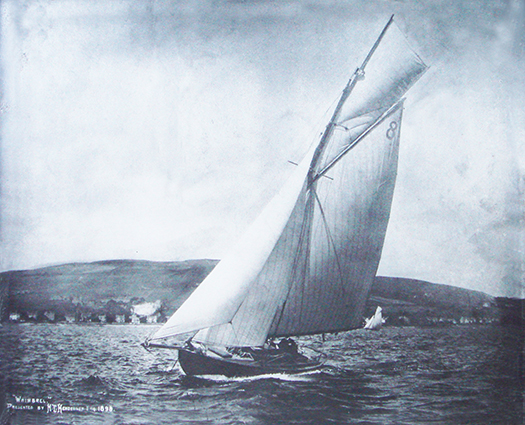
Whimbrel on the Clyde in 1898. They'd the potential to be the world's first offshore one design, but offshore racing hadn't yet been invented. Whimbrel is currently undergoing restoration in Bordeaux. Photo courtesy Gordon Finlay/RUYC
By the middle of the 1898 season, the Belfast Lough One Designs were in all their glory, and our header photo from that season shows a class which surely promised at least a decade of great racing. Yet their peak years barely stretched beyond the turn of the century, and within five years they scarcely existed as a class. Well before the Great War broke out in 1914, they were starting to spread near and far in a scattering which was to continue post war and in most cases ended up in their eventual demise. But remarkably, two have survived and both are undergoing restoration, Whimbrel Number 8 in Bordeaux and Tern, number 7, in Mallorca.
Patricia O'Connell and Alan Renwick live in Palma where he is a master craftsman with Ocean Refits while she – a former Honorary Secretary of a Georgian preservation society in Dublin – has undertaken the tracing of Tern's story, as Tern's restoration is Alan's current project. They arrived in Dublin in the dying days of 2014, and by the time they headed back to Palma well into January, they'd spent time in Cork and Northern Ireland following the old boat's elusive trail, and had also called in Howth to see Ian Malcolm's Howth 17 Aura, which was built in Hilditch's yard within a year of the construction of Tern.
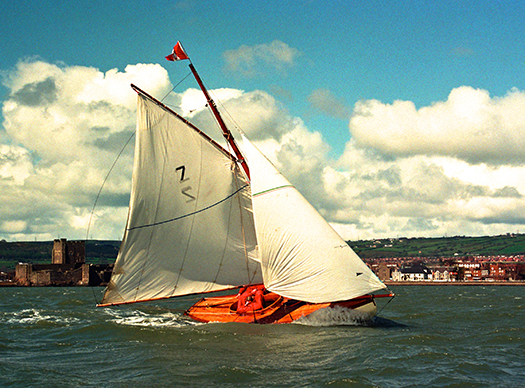
Still going strong. The 1898 Hilditch-built Howth 17 Aura off Carrickfergus Castle for her Centenary, April 1998. With her sister-ships, she then sailed the 90 miles home to Howth. Like Tern, she is number 7 – and like Tern, there's an element of confusion with sail number 2. Photo: David Jones
The original five Carrickfergus-built Howth 17s still sail together as part of a thriving class of twenty Howth 17s. But the impressive class of eight Belfast Lough One Designs from the same era have been remembered for more than a hundred years only as photos on the walls of the Royal Ulster Yacht Club. What went wrong?
The America's Cup – that's what went wrong. In the early years of sailing's premier trophy, there was remarkable Irish involvement. After the schooner America won it with a race round the Isle of Wight in 1851, it took a while to establish a format for races to try and wrest it back from the New York Yacht Club in contests in America. During the 1870s, there were three challenges – two from Britain and one from Canada. Then in the 1880s there were three from Britain and one from Canada, the final one from Britain in 1886 being through the Royal Northern YC of Scotland, but that was because the owner's wife was Scottish – the husband was Lt William Henn whose family home was on the north shore of the Shannon Estuary.
But while the Henn family's hefty cutter Galatea was another unsuccessful challenger, at least she was seen in the waters of the Shannon Estuary. Yet although the first two challenges in the 1890s were by racing machines owned by a yachtsman whose ancestral pile was also on Shannonside, neither boat was seen anywhere near Adare Manor, the home of Lord Dunraven on the south side of the Shannon Estuary, whose two campaigns in 1893 and 1895 were unsuccessful and increasingly acrimonious.
With the passage of time, it becomes increasingly clear that Dunraven got a decidedly raw deal. But in the feverish atmosphere of rapid economic expansion in the 1890s, the world was more interested in pushing ahead with new projects rather than putting right old wrongs. Someone who saw the developing publicity and business potential in the America's Cup was Thomas Lipton, the Scottish-born grocery magnate whose American empire was thriving with a combination of his sheer love of hard work, and gift for publicity.
Lipton had noted the extraordinary level of public interest in Lt & Mrs Henn's "family" challenge in 1886 – they'd actually lived on board the Galatea at he time. But much more importantly, he'd noted the international crisis which arose from the Dunraven affair, and cannily realized that anyone who could smooth the waters with a good-tempered America's Cup challenge would attract acres of favourable coverage, regardless of the actual result.
That said, as a highly competitive individual, there's no doubting he was keen to win. But even though all five of his yachts called Shamrock making his America's Cup challenges between 1899 and 1930 were unsuccessful, with some being much more closely fought than others, he remained resolutely good humoured throughout, and expansion of his retail empire continued unabated. But what's less widely known is that while the America's Cup Shamrocks were numbered I to V, there was a sixth Shamrock, an un-numbered 23 Metre, which raced as his private yacht. It's said that when she didn't perform as well as she should have, the old man could be very grumpy indeed.
But that's all in the future. Here we are in the latter half of the 1890s, and on Belfast Lough this wonderful new class of 37-footers is spreading its wings, thriving on the fact that although the owners lived all round the lough and were members of one yacht club, the Royal Ulster YC founded 1866 and given the "Royal" in 1869, they could feel at home wherever their boats happened to be, as the RUYC had no clubhouse. This was a true sailing club, fixed only to good sailing water, and with the Belfast Lough Number Ones they could sail it well.
It was too good to last. Thomas Lipton was a man in a hurry. He knew that he needed a yacht club of international standing through which to make his first America's Cup challenge. But as he was of humble birth and very much in trade instead of benefitting from inherited wealth, there were few yacht clubs open to him. However, his parents had come from Monaghan, not only in Ireland but particularly in Ulster. In the can-do atmosphere of Belfast in the 1890s, it was indicated that the Royal Ulster might be receptive to his interest. He was soon a member, and plans were roaring ahead for an 1899 Challenge with Shamrock I.
But the RUYC had taken a cuckoo into its nest, or rather its virtual nest. It emerged that a virtual nest was not enough for the aspirations of a serious America's Cup challenger, he needed a real nest. Lipton was soon insisting that his America's Cup challenge, now irreversibly under way, would required the RUYC to have a proper clubhouse impressively sited above the waters of Belfast Lough where it was assumed he would very soon be the defender in the America's Cup.
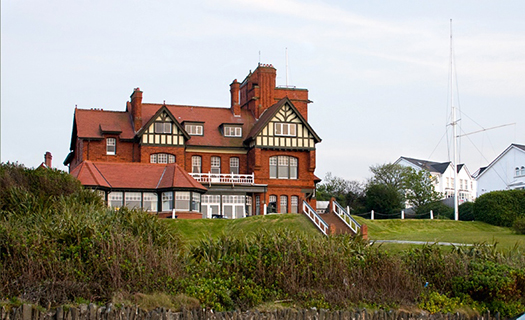
The new RUYC clubhouse was completed at the behest of Thomas Lipton in 1899 after just 18 months work.
And he got his way. An impressive arts and crafts tower-topped clubhouse design was drawn up by James Craig's brother, the architect Vincent Craig, and the new RUYC clubhouse was opened in April 1899, having been built in 18 months flat. Well – not quite flat. They were in such a hurry for completion that there wasn't the time to entirely level the hillside site on the Bangor waterfront where the new clubhouse was built, and even today the ground floor is on two or three different levels.
That said, it's an impressive building to have been put up in such a short time, and somehow they achieved a sort of instant antiquity with it – today it seems much older than its 116 years, and it has always been thus.
But antique or otherwise, it doesn't seem to have been desired by all the members. There were 150 of them, yet only 30 contributed directly to the cost of the new clubhouse. And others took their sailing elsewhere. We live in hope of finding letters or a sailing diary from this period which will tell us what was really going on, for official club committee papers only cover what was on the agenda and recorded in the minutes. Thus even if there was an almighty row going on about the very fact of the somewhat cavalier building of this new clubhouse, at the time it would have been something known to everyone, and talked about by everyone, yet not written down simply because everyone knew of it, and it didn't happen to be directly pertinent to the business of the day. And anyway, once the clubhouse was in being, that was that – the best thing was to get on with living with it.
Yet the fact is that a distinct division arose in sailing along the south coast of Belfast Lough. The conspicuous Royal Ulster YC in Bangor became the public face of yachting in the area. But further up the lough at Cultra beside a roadstead anchorage, what had been a modest canoe club developed in 1899 into an amalgamation of the Ulster Sailing Club with the Cultra Yacht Club to become the North of Ireland Yacht Club, and by 1902 – by which time Lipton had already unsuccessfully challenged twice for the America's Cup through RUYC – the new place at Cultra had become the RNIYC, with a modest clubhouse aimed exclusively at serving its members' sailing needs rather than following grandiose ideas of international yachting campaigns for plutocrats who were only very seldom about the place, if at all.
Inevitably some of the best sailing men in the north were involved with this move to Cultra where many had always anchored their boats in any case, and others had followed. Whether or not the active membership of the RUYC was seriously depleted we can only guess. But the fact is that the relatively small membership of a provincial yacht club had somehow to find, within its membership, the essential people with the necessary talent and experience to provide the back up committee and officer services for Lipton's America's Cup Challenges, with the next one coming along as soon as 1903.

America's Cup design development 1851 to 1930. The Challenge Committee of the RUYC may have come on the scene 48 years after the era of the schooner America, but they still had to cope with the challenges posed by the design development from boats like Reliance in 1903 to the J Class Rainbow in the 1930s.
The drain on RUYC personnel resources was heavy in an era when time-consuming Transatlantic voyages by ship were required for the challenger's committee to meet with the committee of the defending New York Yacht Club. Something just had to give, and it seems to have been the level of personal sailing within RUYC, and particularly with the Number One Class.
The new RNIYC setup at Cultra was establishing its own modest new 22ft OD class, the Linton Hope-designed Fairy Class (also built by Hilditch), so they may well have seen the much larger Number Ones as simply too large, and tainted by the new vulgarity of the RUYC. Whatever the reason, the Belfast Lough Number One Class was a brilliant flame which burned only briefly as a class, even though the boats survived individually with most of them becoming fast cruisers.
But as for the America's Cup, it continued on its melodramatic way, with skulduggery par for the course. After 1903's unsuccessful challenge, when Shamrock III found herself ill-matched against the hyper-giant Reliance, the RUYC committee may have returned home to recuperate and gather strength for Lipton's next campaign. But he was scheming other ideas, and it has been only relatively recently discovered that, unbeknownst to RUYC, he was in preliminary negotiations with the Royal Irish YC on Dublin Bay to organise his fourth challenge.
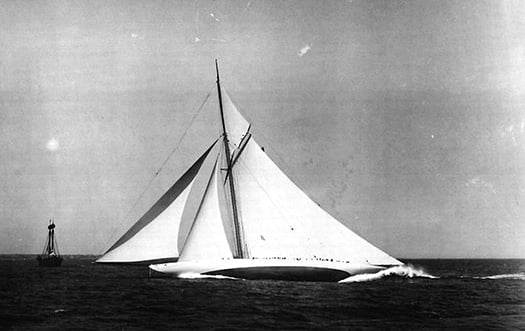
Lipton and the RUYC thought they'd an impressive boat with the Fife-designed Shamrock III in 1903, but this is what they came up against in America – mega-boat Reliance
From a purely commercial point of view, you can understand his thinking. The formerly despised Irish community in the US was expanding rapidly in numbers and prosperity by 1904. Coming in with a challenge through the Royal Irish Yacht Club would hit more market targets than the narrower appeal of a Royal Ulster challenge. It was crude but shrewd business thinking. But fortunately for goodwill in the sailing community, nothing came of it. Challenge 4 through RUYC was slated for 1914, but with the Great War breaking out it was held off - with the radical and very promising Shamrock IV designed by Charles E Nicholson stored in the US – until 1920, with Shamrock IV defeated by the narrowest margin. And then in 1930 came the last challenge, the first with the J Class, but again there was defeat, this time for Shamrock V.
And thus 1930 saw the end of the Royal Ulster YC's tumultuous three decades affair with the Holy Grail of sailing. Since then, other clubs have had their collective finger burnt by the America's Cup. But it usually promises more than it gives. Most recently, sailing has been bluntly reminded of its limited appeal as a spectator sport, even when packaged as America's Cup Plus. The 34th series in San Francisco may have provided some of the most exciting racing ever seen in the event's 164 year history. It made great television for aficionados. And it may have attracted 150,000 shoreside spectators over the length of the series. But let's get it into perspective. San Francisco's Number One tourist attraction is Alcatraz. This island with its former prison fortress linked to the likes of Al Capone and other adornments of American society attracts around a million visitors a year. No matter which way you slice the numbers, that's quite a few more than the America's Cup, it doesn't cost nearly as much, and it's much less trouble to run.
Which goes some way to explain why those of us who live for this crazy old vehicle sport of ours retreat into the happy dreamworld of old boats and their winding journeys through life, often to a wonderful re-birth. And the story of Tern is a classic of its kind. From Belfast Lough she headed some time or other to Cork, we don't quite know when, but we do know she was converted to a yawl for greater ease of handling in 1914. And she was certainly in Cork in the 1920s and 1930s owned seemingly by a loose syndicate, as different owners appear at different times depending on what event she is being entered for, and in 1929 she was one of five yachts taking part in the Irish Cruising Club's Founding Cruise-in-Company to Glengarriff, owned by Capt P F Kelly.
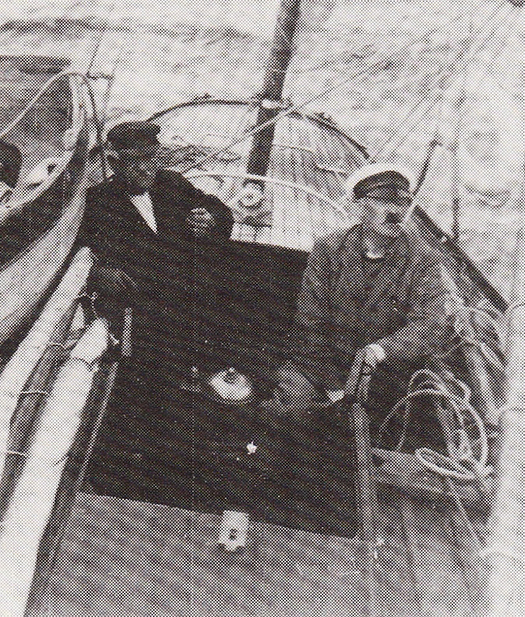
Happy days. Aboard Tern in cruising style, complete with enormous dinghy on the starboard deck, on her way to the founding of the ICC in Glengarriff in 1929 with Captain Kelly and Dr Dan Donovan enjoying the sail
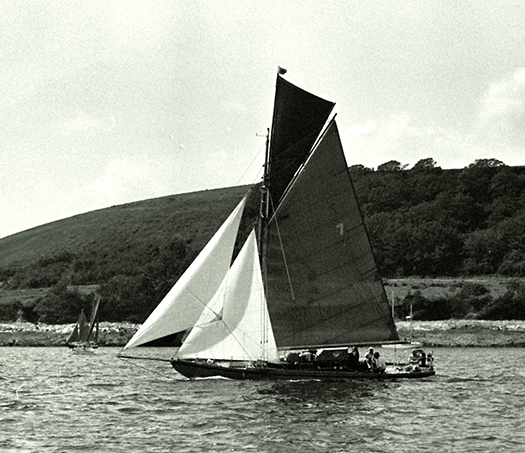
Tern in Falmouth, July 1990. Rot had long since set in within her long and elegant Fife counter, so it had simply been chopped off. Photo: W M Nixon

Tern being overcome by the heat in Andraitx in Mallorca, October 2012. Photo: Patricia Nixon
Yet by 1947 according to Lloyds Register she was in Dun Laoghaire, owned by two members of the National Yacht Club, C E Hogg and M Healy. And then she turns up in Falmouth Harbour in the 1970s and stays there for some time, but she was restored to being a cutter, not with full rig but her mizzen had to be done away with, as there was rot in her long elegant Fife counter, so it was simply chopped off to become like a Laurent Giles stern.
It was then in a little yard in a hidden creek off Falmouth Harbour that she had her first major restoration, and with that she went to the Mediterranean. But by the Autumn of 2012 she was seen in Andraitx looking a bit sorry for herself, and very much for sale. And there she was bought and taken into the specialist yard in Palma, and at the end of December 2014 Patricia O'Connell and Alan Renwick turned up in Ireland and began a pilgrimage.

Alan Renwick and Ian Malcolm aboard the latter's Aura in Howth, December 30th 2014. Aura had Tern have just one year age difference, but the same builder. Photo: W M Nixon
This took them to Howth to see the Hilditch-built Aura (like Tern, she's number 7, and like Tern, at one time her mainsail was mixed up with a number 2). Then it was down to Crosshaven to meet Royal Cork archivist Dermot Burns, who was a fund of information and original material abut Tern's twenty-plus years on Cork Harbour. Then on north to Belfast Lough for a large gathering in the Royal Ulster, a party built around the Charley family, one of whose ancestors owned Tern in 1910, and also brought in folk like noted northern sailing historian Michael Clarke of Lough Erne, and Fife yachts historian Ian McAllister who now lives in Carrickfergus. So you can well imagine that information and ideas overload was a constant risk. But Patricia and Alan survived, they got back to Palma in one piece, the work on Tern resumed, and the Tale of Tern goes on.

There's a Fife hull in there somewhere. Tern in the restoration shed in Palma






























